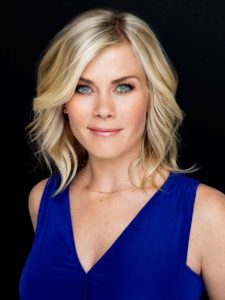
Alison Sweeney
Alison Sweeney is an award-winning actress, TV host, producer, director, content supplier and author who constantly inspires others with her balance of career with her focus on family, health and wellness. Sweeney will next topline THE CHRONICLE MYSTERIES, which was ordered by Hallmark Movies & Mysteries from Sweeney. Combining her passion for true crime podcasts with ROMCOM, Sweeney will both star and executive produce the franchise of movies, with the first slated to premiere later this year. She also will make another a highly anticipated short-term return to DAYS OF OUR LIVES later this year, reprising her 21+ year role of Sami Brady and boosting ratings for the long-running daytime drama.
For more information, visit her on social media:
Facebook IMDB Instagram Twitter
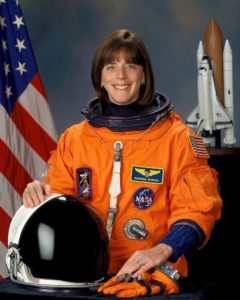
Barbara Morgan
PERSONAL DATA: Born November 28, 1951, in Fresno, California. Married to Clay Morgan. They have two sons. Barbara plays flute and enjoys reading, hiking, swimming, skiing, and her family.
EDUCATION: Hoover High School, Fresno, California, 1969; B.A., Human Biology, with distinction, Stanford University, 1973; Teaching Credential, College of Notre Dame, Belmont, California, 1974; Honorary Doctorate of Science from Boise State University, 2008.
ORGANIZATIONS: National Education Association; Idaho Education Association; National Council of Teachers of Mathematics; National Science Teachers Association; International Reading Association; International Technology Education Association; Challenger Center for Space Science Education.
SPECIAL HONORS: NASA Space Flight Medal; Challenger Center President George H.W. Bush Award; VFW National Space Award; NEA Friend of Education Award; AARP Inspire Award; NSTA Presidential Citation; USA Today Citizen of the Year. Other awards include: NASA Headquarters Special Service Award; NASA Public Service Group Achievement Award; Idaho Fellowship Award; University of Idaho Presidents Medallion Award; ITEA Lawrence Prakken Award; Challenger Center for Space Science Education Challenger 7 Award; National Space Society Space Pioneer Award for Education; Los Angeles Chamber of Commerce Wright Brothers Kitty Hawk Sands of Time Education Award; Women in Aerospace Education Award; National PTA Honorary Lifetime Member; Phi Beta Kappa.
EXPERIENCE: Morgan began her teaching career in 1974 on the Flathead Indian Reservation at Arlee Elementary School in Arlee, Montana, where she taught remedial reading and math. From 1975-1978, she taught remedial reading/math and second grade at McCall-Donnelly Elementary School in McCall, Idaho. From 1978-1979, Morgan taught English and science to third graders at Colegio Americano de Quito in Quito, Ecuador. From l979-l998, she taught second, third, and fourth grades at McCall-Donnelly Elementary School.
NASA EXPERIENCE: Morgan was selected as the backup candidate for the NASA Teacher in Space Program on July 19, 1985. From September 1985 to January 1986, Morgan trained with Christa McAuliffe and the Challenger crew at NASA’s Johnson Space Center, Houston, Texas. Following the Challenger accident, Morgan assumed the duties of Teacher in Space Designee. From March 1986 to July 1986, she worked with NASA, speaking to educational organizations throughout the country. In the fall of 1986, Morgan returned to Idaho to resume her teaching career. She taught second and third grades at McCall-Donnelly Elementary and continued to work with NASA’s Education Division. Her duties as Teacher in Space Designee included public speaking, educational consulting, curriculum design, and serving on the National Science Foundation’s Federal Task Force for Women and Minorities in Science and Engineering.
Selected by NASA as a mission specialist and NASA’s first Educator Astronaut in January 1998, Morgan reported to the Johnson Space Center in August 1998. After completing two years of training and evaluation, she was assigned technical duties in the Astronaut Office Space Station Operations Branch. She then served in the Astronaut Office CAPCOM Branch, working in Mission Control as prime communicator with on-orbit crews. She also served in the Robotics Branch of the Astronaut Office. Morgan has logged over 305 hours in space, completing her first space flight in 2007 as a mission specialist on the crew of STS-118, an assembly mission to the International Space Station.
Barbara Morgan retired from NASA in August, 2008, to become the Distinguished Educator in Residence at Boise State University, with a dual appointment in the colleges of Engineering and Education. She continues to make public appearances.
SPACE FLIGHT EXPERIENCE: STS-118 (August 8-21, 2007) was the 119th space shuttle flight, the 22nd flight to the space station, and the 20th flight for Endeavour. During the mission, Endeavour’s crew successfully added a truss segment, a new gyroscope and external spare parts platform to the International Space Station. They also activated a new system that enables docked shuttles to draw electrical power from the station, extending missions to the outpost. A total of four spacewalks were performed by three crewmembers. Endeavour carried 5,000 pounds of equipment and supplies to the station and returned to Earth with 4,000 pounds of scientific materials and used equipment. Morgan served as educator, loadmaster, shuttle and station robotic arm operator, and flight deck crewmember for entry and landing. Traveling 5.3 million miles in space, the STS-118 mission was completed in 12 days, 17 hours, 55 minutes and 34 seconds.
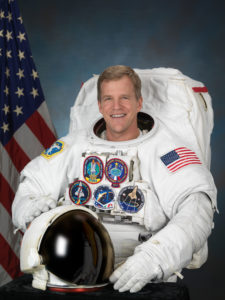
Scott E. Parazynski, M.D.
PERSONAL DATA: Born July 28, 1961, in Little Rock, Arkansas. He has two beautiful children. He enjoys mountaineering, rock climbing, flying, scuba diving, skiing, travel, woodworking and nature photography. A commercial, multi-engine seaplane and instrument-rated pilot, Dr. Parazynski has logged more than 2,500 flight hours in a variety of aircraft. As a mountaineer, he has scaled major mountains in the Alaska Range, the Cascades, the Rockies, the Andes and the Himalayas. His summits include Cerro Aconcagua (22,841 feet above sea level) and all 59 of Colorado’s peaks that are more than 14,000 feet in altitude. After failing to reach the summit of Mount Everest (29,035 feet) in 2008, due to a severe back injury, on May 20, 2009, he became the first astronaut to stand on top of the world.
EDUCATION: Attended junior high school in Dakar, Senegal, and Beirut, Lebanon. Attended high school at the Tehran American School, Iran, and the American Community School, Athens, Greece, graduating in 1979. He received a Bachelor of Science degree in Biology from Stanford University in 1983, continuing on to graduate with honors from Stanford Medical School in 1989. He served his medical internship at the Brigham and Women’s Hospital of Harvard Medical School (1990). He had completed 22 months of a residency program in emergency medicine in Denver, Colorado, when he was selected for the astronaut corps.
ORGANIZATIONS: Fellow of the Aerospace Medical Association and the Explorers Club. Member of the American Society for Gravitational and Space Biology, the Wilderness Medical Society, the American Alpine Club, the Association of Space Explorers and the Aircraft Owners and Pilots Association. Chairman of the Board of the Challenger Center for Space Science Education and Trustee of the Houston Museum of Natural Science.
SPECIAL HONORS: National Institutes of Health Predoctoral Training Award in Cancer Biology (1983); Rhodes Scholarship finalist (1984); NASA Graduate Student Researcher’s Award (1988); Stanford Medical Scholars Program (1988); Research Honors Award from Stanford Medical School (1989); NASA-Ames Certificate of Recognition (1990); Wilderness Medical Society Research Award (1991); Space Station Team Excellence Award (1996); Vladimir Komarov Diploma from the Fédération Aéronautique Internationale (1995, 1999); NASA Exceptional Service Medals (1998, 1999); NASA Space Flight Medals (1994, 1997, 1998, 2001, 2007); NASA Distinguished Service Medals (2002, 2009); Ellis Island Family Heritage Award (2005); Flight Achievement Award from the American Astronomical Association (1998, 2008); Aviation Week Laureate Award (2008); Lowell Thomas Award from the Explorers Club (2008); Randolph C. Lovelace Award from the Society of NASA Flight Surgeons (2008); Arkansas Aviation Hall of Fame (2008); National Eagle Scout Association Outstanding Eagle Award (2012).
While in medical school, Dr. Parazynski competed on the United States Development Luge Team and was ranked among the top 10 competitors in the nation during the 1988 Olympic Trials. He also served as an Olympic Team Coach for the Philippines during the 1988 Olympic Winter Games in Calgary, Canada, and later, as Honorary Captain of the United States Olympic Luge Team during the 2010 Olympic Winter Games in Vancouver, Canada.
EXPERIENCE: While an undergraduate at Stanford University, Dr. Parazynski studied antigenic variation in African Sleeping Sickness, using sophisticated molecular biological techniques. While in medical school, he was awarded a NASA Graduate Student Fellowship and conducted research at NASA-Ames Research Center on fluid shifts that occur during human spaceflight. Additionally, he has been involved in the design of several exercise devices that are being developed for long-duration spaceflight, and he has conducted research on high-altitude acclimatization. Dr. Parazynski has numerous publications in the field of space physiology and has a particular expertise in human adaptation to stressful environments. He has also invented a number of medical devices and other technologies for life in extreme environments.
NASA EXPERIENCE: Selected as an astronaut in March 1992, Dr. Parazynski reported to the Johnson Space Center in August 1992. He completed one year of training and evaluation and was qualified as a mission specialist. Dr. Parazynski initially served as one of the crew representatives for Extravehicular Activity (EVA) in the Astronaut Office Mission Development Branch. Following his first flight, he was assigned as a backup for the third American long-duration stay aboard Russia’s Space Station Mir and was expected to serve as a prime crew member on a subsequent mission. He spent five months in training at the Gagarin Cosmonaut Training Center, Star City, Russia. In October 1995, when sitting-height parameters raised concerns about his fitting safely in the Soyuz vehicle in the event of an emergency aboard the Mir station, he was deemed too tall for the mission and was withdrawn from Mir training. He has served as the Astronaut Office crew representative for space shuttle, space station and Soyuz training, as Deputy (Operations and Training) of the Astronaut Office ISS Branch, and as Chief of the Astronaut Office EVA Branch. In the aftermath of the Columbia tragedy, he was the Astronaut Office lead for space shuttle thermal protection system inspection and repair. A veteran of five spaceflights, STS-66 (1994), STS-86 (1997), STS-95 (1998), STS-100 (2001) and STS-120 (2007), Dr. Parazynski has logged more than 1,381 hours (over eight weeks) in space, including more than 47 hours during seven spacewalks, and has traveled more than 23 million miles. Dr. Parazynski retired from NASA in March 2009 to work in private industry and to pursue other entrepreneurial and exploration interests.
SPACEFLIGHT EXPERIENCE: The STS-66 Atmospheric Laboratory for Applications and Science-3 (ATLAS-3) mission launched from Kennedy Space Center, Florida, on November 3, 1994, and returned to land at Edwards Air Force Base, California, on November 14, 1994. ATLAS-3 was part of an on-going program to determine the Earth’s energy balance and atmospheric change over an 11-year solar cycle, particularly with respect to humanity’s impact on global-ozone distribution. Dr. Parazynski had responsibility for a number of in-orbit activities, including the operation of the ATLAS experiments and Spacelab Pallet, as well as several secondary experiments in the crew cabin. The crew also successfully evaluated the Interlimb Resistance Device, a free-floating exercise he co-invented to prevent musculoskeletal atrophy in microgravity. Space shuttle Atlantis circled the earth 175 times and traveled more than 4.5 million miles during its 262-hour and 34-minute flight.
STS-86 Atlantis (September 25 to October 6, 1997) was the seventh mission to rendezvous and dock with the Russian Space Station Mir. Highlights of the mission included the exchange of U.S. crew members Mike Foale and David Wolf, the transfer of 10,400 pounds of science and logistics and the first shuttle-based joint American-Russian spacewalk. Dr. Parazynski served as the flight engineer (MS2) during the flight and was also the navigator during the Mir rendezvous. Dr. Parazynski (EV1) and Russian cosmonaut Vladimir Titov performed a five-hour and one-minute spacewalk, during which they retrieved four experiment packages that were first deployed during the STS-76 shuttle-Mir docking mission. They also deployed the Spektr Solar Array Cap, which was designed to be used in a future Mir spacewalk to seal a leak in the Spektr module’s damaged hull. Other objectives of spacewalk included the evaluation of common spacewalk tools to be used by astronauts wearing either Russian- or American-made spacesuits, and a systems flight test of the Simplified Aid for EVA Rescue (SAFER). Space shuttle Atlantis circled the earth 169 times and traveled more than 4.2 million miles during its 259-hour and 21-minute flight.
STS-95 Discovery (October 29 to November 7, 1998) was a nine-day mission, during which the crew supported a variety of research payloads, including the deployment of the Spartan solar-observing spacecraft and the testing of the Hubble Space Telescope Orbital Systems Test Platform. The crew also conducted investigations on the correlation between spaceflight and the aging process. Dr. Parazynski was the flight engineer (MS2) for the mission as well as the navigator for the Spartan spacecraft rendezvous. During the flight, he also operated the shuttle’s robotic arm in support of the testing of several space-vision systems being considered for station assembly. In addition, he was responsible for monitoring several life sciences investigations, including those involving crewmate Senator John Glenn. The mission was accomplished in 134 Earth orbits, traveling 3.6 million miles in 213 hours and 44 minutes.
STS-100 Endeavour (April 19 to May 1, 2001) was the ninth mission to the International Space Station, during which the crew successfully delivered and installed the space station “Canadarm2” robotic arm, to be used for all future space station assembly and maintenance tasks. Dr. Parazynski conducted two spacewalks with Canadian colleague, Chris Hadfield, to assemble and power the next-generation robotic arm. Additionally, the pair installed a new UHF radio antenna for space‑to‑space communications during space shuttle rendezvous and station spacewalk activity. A critical in-orbit spare, a direct current switching unit, was also transferred to the space station during the 14-hour and 50-minute spacewalk. Also during the flight, Dr. Parazynski operated Endeavour’s robotic arm to install, and later remove, the Italian-built “Raffaello” Multi-Purpose Logistics Module. Traveling 4.9 million miles in 283 hours and 30 minutes, the mission was accomplished in 186 Earth orbits.
STS-120 Discovery (October 23 to November 7, 2007) launched from and returned to land at Kennedy Space Center. During the mission, the Node 2 module named “Harmony” was delivered to the International Space Station. This element opened up the capability for future international laboratories to be added to the station. Dr. Parazynski served as EV1 (lead spacewalker) and accumulated more than 27 hours in four spacewalks. One of the major spacewalk mission objectives was the relocation of the P6 solar array from the top of the Z1 truss to the end of the port side of the integrated truss structure. During the IVA-commanded redeploy of the solar array, several array panels snagged and were damaged, requiring an unplanned spacewalk to successfully repair the array. The mission was accomplished in 238 orbits, traveling 6.2 million miles in 15 days, two hours, and 23 minutes.
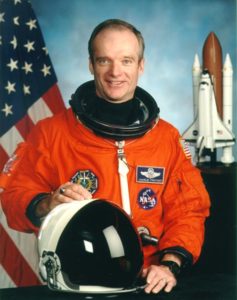
Charles J. Precourt, Col. (USAF, Ret.)
PERSONAL DATA: Born June 29, 1955, in Waltham, Massachusetts, but considers Hudson, Massachusetts, to be his hometown. Married to the former Lynne Denise Mungle of St. Charles, Missouri. They have three daughters, Michelle, Sarah, and Aimee. Precourt enjoys golf and flying light aircraft. He flies a Varieze, an experimental aircraft that he built. His parents, Charles and Helen Precourt, reside in Hudson. Her mother, Jerry Mungle, resides in Pearland, Texas.
EDUCATION: Graduated from Hudson High School, Hudson, Massachusetts, in 1973; received a bachelor of science degree in aeronautical engineering from the United States Air Force Academy in 1977, a master of science degree in engineering management from Golden Gate University in 1988, and a master of arts degree in national security affairs and strategic studies from the United States Naval War College in 1990. While at the United States Air Force Academy, Precourt also attended the French Air Force Academy in 1976 as part of an exchange program. Fluent in French and Russian.
ORGANIZATIONS: Vice President of the Association of Space Explorers; Associate Fellow of the Society of Experimental Test Pilots (SETP), and member of the Experimental Aircraft Association.
SPECIAL HONORS: Military decorations include: the Legion of Merit, the Defense Superior Service Medal (2); the Distinguished Flying Cross and the Air Force Meritorious Service Medal (2). Distinguished graduate of the United States Air Force Academy and the United States Naval War College. In 1978 he was the Air Training Command Trophy Winner as the outstanding graduate of his pilot training class. In 1989 he was recipient of the David B. Barnes Award as the Outstanding Instructor Pilot at the United States Air Force Test Pilot School. NASA awards include: the NASA Distinguished Service Medal; the Exceptional Service Medal and Outstanding Leadership Medal; and the NASA Space Flight Medal (4).
EXPERIENCE: Precourt graduated from Undergraduate Pilot Training at Reese Air Force Base, Texas, in 1978. Initially he flew as an instructor pilot in the T-37, and later as a maintenance test pilot in the T-37 and T-38 aircraft. From 1982 through 1984, he flew an operational tour in the F-15 Eagle at Bitburg Air Base in Germany. In 1985 he attended the United States Air Force Test Pilot School at Edwards Air Force Base in California. Upon graduation, Precourt was assigned as a test pilot at Edwards, where he flew the F-15E, F-4, A-7, and A-37 aircraft until mid 1989, when he began studies at the United States Naval War College in Newport, Rhode Island. Upon graduation from the War College, Precourt joined the astronaut program. His flight experience includes over 7,500 hours in over 60 types of civil and military aircraft. He holds commercial pilot, multi-engine instrument, glider and certified flight instructor ratings. Precourt retired from the Air Force on March 31, 2000.
NASA EXPERIENCE: Selected by NASA in January 1990, Precourt became an astronaut in July 1991. His other technical assignments to date have included: Manager of ascent, entry, and launch abort issues for the Astronaut Office Operations Development Branch; spacecraft communicator (CAPCOM), providing the voice link from the Mission Control Center during launch and entry for several Space Shuttle missions; Director of Operations for NASA at the Gagarin Cosmonaut Training Center in Star City, Russia, from October 1995 to April 1996, with responsibility for the coordination and implementation of mission operations activities in the Moscow region for the joint U.S./Russian Shuttle/Mir program. From May 1996 to September 1998, he served as Acting Assistant Director (Technical), Johnson Space Center. From October 1998 through November 2002, Precourt was Chief of the Astronaut Corps, responsible for the mission preparation activities of all space shuttle and future International Space Station crews and their support personnel. In his final assignment he was the Deputy Manager for the International Space Station, responsible for the day-to-day management of ISS operations, on orbit assembly and the interfaces with NASA contractors and the International Partners. A veteran of four space flights, he has logged over 932 hours in space. He served as a mission specialist on STS-55 (April 26 to May 6, 1993), was the pilot on STS-71 (June 27 to July 7, 1995), and was the spacecraft commander on STS-84 (May 15-24, 1997) and STS-91 (June 2-12, 1998), the final scheduled Shuttle-Mir docking mission, concluding the joint U.S./Russian Phase I Program. Precourt left NASA in March 2005 and is now working for Thiokol in Utah.
SPACE FLIGHT EXPERIENCE: STS-55 Columbia launched from Kennedy Space Center, Florida, on April 26, 1993. Nearly 90 experiments were conducted during this German-sponsored Spacelab D-2 mission to investigate life sciences, materials sciences, physics, robotics, astronomy and the Earth and its atmosphere. STS-55 also flew the Shuttle Amateur Radio Experiment (SAREX) making contact with students in 14 schools around the world. After 160 orbits of the earth in 240 flight hours, the 10-day mission concluded with a landing on Runway 22 at Edwards Air Force Base, California, on May 6, 1993.
STS-71 (June 27 to July 7, 1995) was the first Space Shuttle mission to dock with the Russian Space Station Mir, and involved an exchange of crews (seven-member crew at launch, eight-member crew on return). The Atlantis Space Shuttle was modified to carry a docking system compatible with the Russian Mir Space Station. It also carried a Spacehab module in the payload bay in which the crew performed various life sciences experiments and data collections. STS-71 Atlantis launched from and returned to land at the Kennedy Space Center, Florida. Mission duration was 235 hours, 23 minutes.
STS-84 Atlantis (May 15-24, 1997) carried a seven-member international crew. This was NASA’s sixth Shuttle mission to rendezvous and dock with the Russian Space Station Mir. During the 9-day flight, the crew conducted a number of secondary experiments and transferred nearly 4 tons of supplies and experiment equipment between the Space Shuttle and the Mir station. STS-84 Atlantis launched from and returned to land at the Kennedy Space Center, Florida. Mission duration was 221 hours and 20 minutes.
STS-91 Discovery (June 2-12, 1998) was the 9th and final Shuttle-Mir docking mission and marked the conclusion of the highly successful joint U.S./Russian Phase I Program. The crew, including a Russian cosmonaut, performed logistics and hardware resupply of the Mir during four docked days. They also conducted the Alpha Magnetic Spectrometer experiment, which involved the first of its kind research of antimatter in space. Mission duration was 235 hours, 54 minutes.
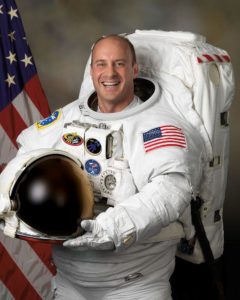
Garrett Reisman, Ph.D.
DATA: Born February 10, 1968, in Morristown, New Jersey, but considers Parsippany, New Jersey, to be his hometown. Recreational interests include flying, skiing, snowboarding, rock climbing, mountaineering, canyoneering and scuba diving. Dr. Reisman is an FAA certified flight instructor. His parents are Sheila Reisman of Boynton Beach, Florida, and the late Robert Reisman. His sister, Lainie Reisman, is an international youth violence prevention specialist, who currently resides in Nairobi, Kenya.
EDUCATION:
Parsippany High School, Parsippany, New Jersey, 1986
B.S., economics, University of Pennsylvania, 1991
B.S., mechanical engineering and applied mechanics, University of Pennsylvania, 1991
M.S., mechanical engineering, California Institute of Technology, 1992.
Ph.D., mechanical engineering, California Institute of Technology, 1997.
EXPERIENCE: From 1996 to 1998, Dr. Reisman was employed by TRW as a spacecraft guidance, navigation and control engineer in the Space and Technology Division, Redondo Beach, California. While at TRW, he designed the thruster-based attitude control system for the NASA Aqua spacecraft.
Prior to his employment at TRW, Dr. Reisman was a Ph.D. candidate at Caltech in the Division of Engineering and Applied Science in Pasadena, California. His multiphase fluid mechanics research provided the first experimental evidence of the presence of shock waves in unsteady cloud cavitation.
NASA EXPERIENCE: Selected by NASA as a mission specialist in June 1998, Dr. Reisman reported for training in August 1998. Astronaut Candidate Training included orientation briefings and tours, numerous scientific and technical briefings, intensive instruction in shuttle and International Space Station (ISS) systems, physiological training and ground school to prepare for T-38 flight training as well as learning water and wilderness survival techniques.
After completing this training, Dr. Reisman was assigned to the Astronaut Office Robotics Branch where he worked primarily on the ISS robotic arm.
In October 2001, Dr. Reisman was assigned to the Astronaut Office Advanced Vehicles Branch, where he worked on the displays and checklists to be used in the next-generation space shuttle cockpit.
In June 2003, Dr. Reisman was a crewmember on NEEMO V, living on the bottom of the sea in the Aquarius habitat for 2 weeks.
Dr. Reisman completed his first space flight in 2008, logging more than 3 months in space and 7 hours and 01 minute of EVA in one spacewalk. In 2010, he completed his second mission on the crew of STS-132 and logged an additional 11 days, 18 hours, 28 minutes and 2 seconds in space, including two more spacewalks for a total of 21 hours and 12 minutes of EVA in three spacewalks.
Dr. Reisman left NASA in March 2011 and is currently working for SpaceX in Hawthorne, California.
SPACE FLIGHT EXPERIENCE: During his first space mission, Dr. Reisman served with both the Expedition 16 and Expedition 17 crews as a flight engineer aboard the ISS. He launched with the STS-123 crew aboard the Space Shuttle Endeavour on March 11, 2008 and returned to Earth with the crew of STS-124 aboard the Space Shuttle Discovery on June 14, 2008. During his 3-month tour of duty aboard the ISS, Dr. Reisman performed one spacewalk totaling 7 hours and 01 minutes of EVA and executed numerous tasks with the ISS robotic arm and the new robotic manipulator, Dextre.
During Dr. Reisman’s second space mission, STS-132, he served as mission specialist 1 aboard the Space Shuttle Atlantis, which launched on May 14, 2010. During the STS-132 mission, Dr. Reisman operated the ISS robotic arm and installed the Russian-built Mini Research Module to the ISS. During 7 days of docked operations, Dr. Reisman conducted two spacewalks, logging 14 hours and 11 minutes of EVA. During these two spacewalks, Dr. Reisman installed a spare antenna and a stowage platform for Dextre, replaced the last of the P6 truss batteries and retrieved a power data grapple fixture. The STS-132 mission was completed in 186 orbits, traveling 4,879,978 miles in 11 days, 18 hours, 28 minutes and 2 seconds.
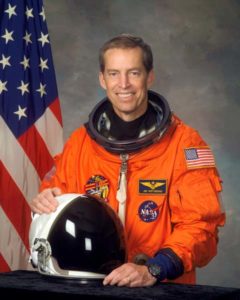
PERSONAL DATA: Born November 27, 1952, in Flushing, New York. Raised in Huntington Station, New York. Married to the former Robin DeVore Platt of Jacksonville, Florida.
James Wetherbee, Capt. (USN, Ret.)
EDUCATION: Graduated from Holy Family Diocesan High School, South Huntington, New York, in 1970; received a bachelor of science degree in aerospace engineering from the University of Notre Dame in 1974.
ORGANIZATIONS: Lifetime Member of the Society of Experimental Test Pilots; Honorary Member, Musicians’ Union, Local 47, American Federation of Musicians, Los Angeles, CA.
SPECIAL HONORS: Distinguished Flying Cross; Navy Achievement Medal; two Meritorious Unit Commendations; six Space Flight Medals; two Outstanding Leadership Medals; four Distinguished Service Medals.
EXPERIENCE: Wetherbee received his commission in the United States Navy in 1975 and was designated a naval aviator in December 1976. After training in the A-7E, he was assigned to Attack Squadron 72 (VA-72) from August 1977 to November 1980 aboard the USS John F Kennedy and logged 125 night carrier landings. After attending the U.S. Naval Test Pilot School, Patuxent River, Maryland, in 1981 he was assigned to the Systems Engineering Test Directorate. He was a project officer and test pilot for the weapons delivery system and avionics integration for the F/A-18 aircraft. Subsequently assigned to Strike Fighter Squadron 132 (VFA-132), he flew operationally in the F/A-18 from January 1984 until his selection for the astronaut candidate program. He has logged over 7,000 hours flying time in 20 different types of aircraft, including 345 carrier landings.
NASA EXPERIENCE: Selected by NASA in May 1984, Wetherbee became an astronaut in June 1985. A veteran of six space flights, Wetherbee logged over 1,592 hours in space, and is the first American to command five space missions. He was the pilot on STS-32 (1990), and was the mission commander on STS-52 (1992), STS-63 (1995), STS-86 (1997), STS-102 (2001), and STS-113 (2002). He served as Deputy Director of the Johnson Space Center (August 1995 to April 2000), Director of the Flight Crew Operations Directorate (April 2000-2002), and Technical Assistant to the Director of JSC’s Safety & Mission Assurance Directorate (April 2003 to June 2004). Wetherbee left NASA in January 2005 to form Escape Trajectory LLC. In December 2006, he began working as a Safety Auditor with BP.
SPACE FLIGHT EXPERIENCE: Pilot, STS-32 Columbia (January 9-20, 1990). Rendezvous and recovery of the 21,400-pound Long Duration Exposure Facility (LDEF) satellite. Intended for retrieval after one year, the LDEF satellite was stranded in orbit for six years after the Challenger accident. The crew recovered the LDEF from its decaying orbit two months before it would have re-entered the Earth’s atmosphere and would have been destroyed. The crew deployed the Syncom IV-F5 satellite, operated a variety of mid-deck experiments, and conducted numerous medical test objectives, including in-flight aerobic exercise and muscle performance to evaluate human adaptation to extended duration missions. Mission duration was 261 hours in 173 orbits.
Commander, STS-52 Columbia (October 22 to November 1, 1992). Deployed the Laser Geodynamic Satellite (LAGEOS). Researchers on this joint Italian-American project have measured the speed of tectonic plate movement of the California shelf with an accuracy of 7 centimeters per year. Separately, after analyzing the motion of LAGEOS for 11 years, scientists confirmed the “Frame Dragging” effect, a key prediction of Einstein’s general theory of relativity, which proves the mass of the earth drags spacetime with it as it rotates. The crew operated the first U.S. Microgravity Payload (USMP) with French and American experiments, and successfully completed the initial flight tests of the Canadian-built Space Vision System (SVS). Mission duration was 236 hours.
Commander, STS-63 Discovery (February 2-11, 1995). First American flight operations with the Russian Space Station, Mir; first flight with NASA woman pilot. This test flight was a checkout of the rendezvous and navigation procedures, and included a close approach of the 100-ton Space Shuttle to 10 meters from the docking port of Mir. The mission included operation of the Spacehab module and associated experiments, and the deployment and retrieval of the Spartan-204 satellite. The mission was accomplished in 198 hours in 129 orbits.
Commander, STS-86 Atlantis (September 25 to October 6, 1997). This was the seventh mission to rendezvous and dock with the Russian Space Station Mir. This was the first flight to dock with the damaged Mir after the collision with the Russian Progress vehicle, which impacted and depressurized the Spectr module of Mir. Highlights included the delivery of a Mir attitude control computer, which had failed on the three previous Sundays before the launch of Atlantis. The flight involved the exchange of U.S. crewmembers, the first space walk by a Russian Cosmonaut, Vladimir Titov, from an American vehicle, the transfer to Mir of 10,400 pounds of science and logistical equipment, and the return of experiment hardware and results to Earth. Mission duration was 259 hours in 169 orbits.
Commander, STS-102 Discovery (March 8-21, 2001). This was the first crew exchange mission to the permanently inhabited International Space Station. Mission accomplishments included the delivery of the Expedition Two crew and the contents of the Leonardo Multi-Purpose Logistics Module, the completion of two successful space walks, the return to earth of the Expedition One crew, as well as the return of Leonardo, the reusable cargo carrier built by the Italian Space Agency. Mission duration was 307 hours and included the longest docked time of any space mission.
Commander, STS-113 Endeavour (November 23-Dec 7, 2002). This was the first combined crew exchange and major assembly mission to visit the International Space Station. Mission accomplishments included the delivery of the Expedition Six crew, the delivery, installation and activation of the P1 Truss, and the transfer of cargo from Shuttle to the Station. During the mission, the robot arm of the Space Shuttle Endeavour was used to hand the 28,000 pounds-mass truss to the Station for installation. STS-113 returned the Expedition Five crew to earth following their 6-month stay aboard the Station. Mission duration was 330 hours.
